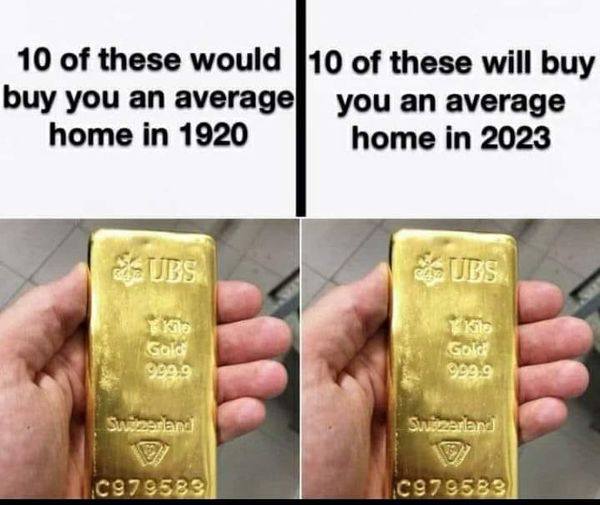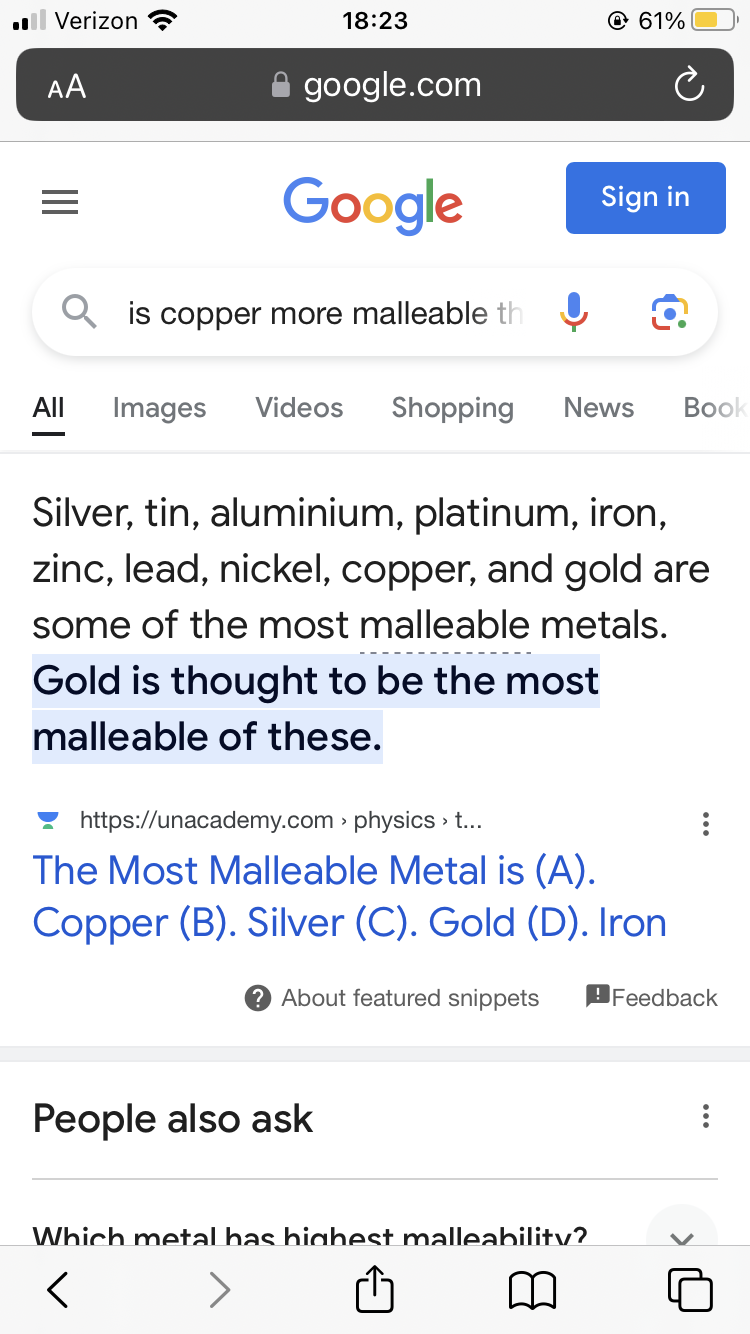this post was submitted on 28 Jan 2024
249 points (74.9% liked)
Memes
50526 readers
643 users here now
Rules:
- Be civil and nice.
- Try not to excessively repost, as a rule of thumb, wait at least 2 months to do it if you have to.
founded 6 years ago
MODERATORS
you are viewing a single comment's thread
view the rest of the comments
view the rest of the comments

This isn’t actually true. In the US, housing has outpaced the value of gold.
In 2023, you would need 254.7 ounces of gold to buy a house, since $495,100 avg home / $1,943 price of gold = 254.7
In 1920, you would need 164.1 ounces of gold to buy a house, since $3,395 avg home / $20.67 price of gold = 164.1.
Fuck, even the gold isn't safe.
The same can be said for banknotes, they are quite useless as paper, they are mostly valuable because people see them as valuable and perceptions can change
I'm gonna start carrying houses, food and water in my wallet instead
Dragon ball had it right. Fuck storing Pokémon. I wanna carry around my house
Right, which is why using gold for a currency replacement is folly. They're both valued based on something other than their real world applications, so if you trust one to stay relevant, you should probably trust the second as well.
Right but at least bank notes are easy to use and don't require a scale.
Crypto Bois reading this
Yes and no.
Gold has been used as a currency historically for many reasons. It's inert. It has a low melting point. It's malleable and easily divisible. It doesn't tarnish. A piece of gold from 2,000 years ago will be the same weight today as it was then. It also is attractive, which gives it value for jewelry. And, importantly, it's predictably rare and can be mined.
Today, it's also valuable for electronics. Its inability to tarnish makes it fantastic if you need a connection to be corrosion resistant.
There's a reason gold still holds its value even though it's not used for currency anymore.
Gold's value isn't tied to its usefulness. Based on statista, less than 7% of global gold use is for "technology". The rest of it goes to jewellery, investments and banks.
The quantity you need for gold to be as useful as it's going to be in whatever application short of aesthetic/monetary value is so low that it just doesn't make sense for its value to be tied to its actual use. So little gold is used for "real" applications that if that was driving its valuation , it'd be probably 10% as valuable as it is. That's what people mean when they say it isn't useful.
I’m pretty sure you are wrong about that. Gold is one of the best conductors, it is extremely malleable, used in dentistry and medicine, electronics, it even protects against radiation.
Gold is extremely useful, just an fyi you are incorrect
You are incorrect, but I don’t really care that much
If they produce mass H2 burning cells gold and platinum will rise in price drastically
And let‘s not forget that the average home in 1920 was way more modest than today‘s average home.
The bar in the picture says it's a kilo which is $65, 344. While I could agree with OP that 10 kilos would give you an average house in higher priced areas like new York or LA, it would definitely buy you several nice houses in 1920.
Now you could buy a house, then you could buy a neighbourhood.
I'm seeing $412K as the average price of a home in 2023, not $495K. And gold was $2,135 in 2023. The price in gold is still higher in 2023, though about 193 bars for a home.
Couple other notes, more related to the post.
1920 is an oddly good year to use. It's just after WWI. Industrialization and modernization are taking off across the US. Worker's rights are beginning to take hold and working class people are now able to afford homes. It's before the Roaring 20s, so you're not going to get the actual details obscured with the market rush and subsequent depression.
There is a couple important downsides though...
Firstly, mortgages didn't really exist back then. I mean, they did, but they were horrific. You'd have to go to an insurance company because banks wouldn't offer them. The terms would give the insurance company full ownership of the property. If you were lucky, it would be a balloon loan - pay only the interest during the 5-10 year term and then pay the entire balance at the end. If you were less lucky, it was a lifelong contract where you only paid the interest plus fees every month.
There was an alternative but most people didn't have access to it: membership in a Savings and Loan corporation, also known as Building and Loan or thrifts. You'd join as a member and agree to buy X shares every month. If you give a notice (30-90 days usually), you would be allowed to cash out the shares plus interest earned for their actual value. When you wanted to buy a home, you would be allowed to use your shares as collateral. Each monthly payment would pay for the interest and a certain number of shares. Once you had enough shares, you would redeem them to pay off the loan. A bit complicated, but S&Ls were fantastic for the common person. They were owned by the members of your community and all loans went to support said community.
Secondly, kind of related to the first point, there were no 30 year mortgages. Home prices are virtually tied to the monthly payment and a thirty year mortgage allows for lower monthly payments. Prices might get out of line a bit, such as right now, if people believe that interest rates will drop and they can refinance later. Personally, I don't think we'll see any drops for at least two years and, even then, we won't see anything like the 2020-2021 rates unless we experience an economic catastrophe like 2008. You want higher rates when the macro environment is strong and lower rates when it's weak. Cheap debt in a good economy is basically a handout to the rich - makes you wonder why Trump pushed the Fed to keep them low back in 2018-2019...
Which week are we talking about? Lol
Is there a "they did the math" community here yet?